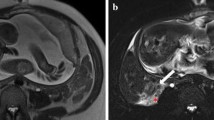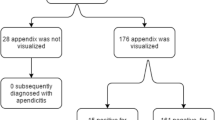Abstract
Purpose
To retrospectively assess the performance of MR imaging in the evaluation and triage of pregnant patients presenting with acute abdominal or pelvic pain.
Method and materials
MRI studies of pregnant patients who were referred for acute abdominal pain between 2001 and 2007 were included. MR images were retrospectively reviewed and compared with surgical and pathologic findings and clinical follow-up data. Analysis of imaging findings included evaluation of the visceral organs, bowel and mesentery, appendix (for presence of appendicitis), ovaries (detection and adnexal masses were evaluated), focal inflammation, presence of abscesses, and any other abnormal findings.
Results
A total of 118 pregnant patients were included. MR findings were inconclusive in 2 patients and were positive for acute appendicitis in 11 patients (n = 9 confirmed by surgery, n = 2 improved without surgery). One patient with inconclusive MR had surgically confirmed appendicitis; the other patient with inconclusive MR had surgically confirmed adnexal torsion. Other surgical/interventional diagnoses suggested by MR imaging were adnexal torsion (n = 4), abscess (n = 4), acute cholecystitis (n = 1), and gastric volvulus (n = 1). Two patients with MR diagnosis of torsion improved without surgery. One patient with MR diagnosis of abscess had biliary cystadenoma at surgery. The rest of the MR diagnoses above were confirmed surgically or interventionally. MR imaging was normal in 67 patients and demonstrated medically treatable etiology in 28 patients: adnexal lesions (n = 9), urinary pathology (n = 6), cholelithiasis (n = 4), degenerating fibroid (n = 3), DVT (n = 2), hernia (n = 1), colitis (n = 1), thick terminal ileum (n = 1), rectus hematoma (n = 1). Three of these patients had negative surgical exploration and one had adnexal mass excision during pregnancy. Other patients were discharged with medical treatment. The sensitivity, specificity, accuracy, positive predictive values (ppv), and negative predictive values (npv) of MR imaging for acute appendicitis, and surgical/ interventional diagnoses were 90.0% vs. 88.9%, 98.1% vs. 95.0%, 97.5% vs. 94.1%, 81.8% vs. 76.2%, 99.1% vs. 97.9%, respectively.
Conclusion
MR imaging is an excellent modality for diagnosis of acute appendicitis and exclusion of diseases requiring surgical/interventional treatment. Therefore MR imaging is useful for triage of pregnant patients with acute abdominal and pelvic pain.



Similar content being viewed by others
References
Cappell MS, Friedel D (2003) Abdominal pain during pregnancy. Gastroenterol Clin North Am 32:1–58
Baer JL, Reis RA, Arens RA (1932) Appendicitis in pregnancy. JAMA 52:1359–1364
Oto A, Srinivasan PN, Ernst RD, et al. (2006) Revisiting MRI for appendix location during pregnancy. AJR 186:883–887
Cobben LP, Groot I, Haans L, et al. (2004) MRI for clinically suspected appendicitis during pregnancy. AJR 183:671–675
Birchard KR, Brown MA, Hyslop WB, et al. (2005) MRI of acute adominal and pelvic pain in pregnant patients. AJR 184:452–458
Oto A, Ernst RD, Shah R, et al. (2005) Right-lower-quadrant pain and suspected appendicitis in pregnant women: evaluation with MR imaging-initial experience. Radiology 234:445–451
Pedrosa I, Levine D, Eyvazzadeh AD, et al. (2006) MR imaging evaluation of acute appendicitis in pregnancy. Radiology 238:891–899
Rha SE, Byun JY, Jung SE et al. (2002) CT and MR imaging features of adnexal torsion. RadioGraphics 22:283–294
Born C, Wirth S, Stabler A, et al. (2004) Diagnosis of adnexal torsion in the third trimester of pregnancy: a case report. Abdom Imaging 29:123–127
Spencer JA, Chahal R, Kelly A, et al. (2004) Evaluation of painful hydronephrosis in pregnancy: magnetic resonance urographic patterns in physiological dilatation versus calculous obstruction. J Urol 171:256–260
Sharp HT (2002) The acute abdomen during pregnancy. Clin Obstet Gynecol 45:405–413
Stone K (2002) Acute abdominal emergencies associated with pregnancy. Clin Obstet Gynecol 45:553–561
Sharp HT (1994) Gastrointestinal surgical conditions during pregnancy. Clin Obstet Gynecol 37:306–315
Mortele KJ, Ros PR (2001) Cystic focal liver lesions in the adult: differential CT and MR imaging features. Radiographics 21:895–910
Shellock FG, Kanal E (1999) Safety of magnetic resonance imaging contrast agents. J Magn Reson Imaging 10:477–484
Novak Z, Thurmond AS, Ross PL, et al. (1993) Gadolinium-DTPA transplacental transfer and distribution in fetal tissue in rabbits. Invest Radiol 28:828–830
Chapon C, Franconi F, Roux J, et al. (2005) Prenatal evaluation of kidney function in mice using dynamic contrast-enhanced magnetic resonance imaging. Anat Embryol (Berl) 209:263–267
Kanal E, Barkovich AJ, Bell C, et al. (2007) ACR guidance document for safe MR practices: 2007. AJR 188:1–27
Lim HK, Bae SH, Seo GS (1992) Diagnosis of acute appendicitis in pregnant women: value of sonography. AJR 159:539–542
Barloon TJ, Brown BP, Abu-Yousef MM, et al. (1995) Sonography of acute appendicitis in pregnancy. Abdom Imaging 20:149–151
Kok RD, de Vries MM, Heerschap A, et al. (2004) Absence of harmful effects of magnetic resonance exposure at 1.5T in utero during the third trimester of pregnancy: a follow-up study. Magn Reson Imaging 22(6):851–854
Baker PN, Johnson IR, Harvey PR, et al. (1994) A three-year follow-up of children imaged in utero with echo-planar magnetic resonance. Am J Obstet Gynecol 170:32–33
Myers C, Duncan KR, Gowland PA, et al. (1998) Failure to detect intrauterine growth restriction following in utero exposure to MRI. Br J Radiol 71(845):549–551
Clements H, Duncan KR, Fielding K, et al. (2000) Infants exposed to MRI in utero have a normal paediatric assessment at 9 months of age. Br J Radiol 73(866):190–194
US Food and Drug Administration (1988) Magnetic resonance diagnostic device: panel recommendation and report on petitions for MR classification. Fed Reg 53:7575–7579
Kirshenbaum M, Mishra V, Kuo D, et al. (2003) Resolving appendicitis: role of CT. Abdom Imaging 28:276–279
Author information
Authors and Affiliations
Corresponding author
Rights and permissions
About this article
Cite this article
Oto, A., Ernst, R.D., Ghulmiyyah, L.M. et al. MR imaging in the triage of pregnant patients with acute abdominal and pelvic pain. Abdom Imaging 34, 243–250 (2009). https://doi.org/10.1007/s00261-008-9381-y
Published:
Issue Date:
DOI: https://doi.org/10.1007/s00261-008-9381-y




